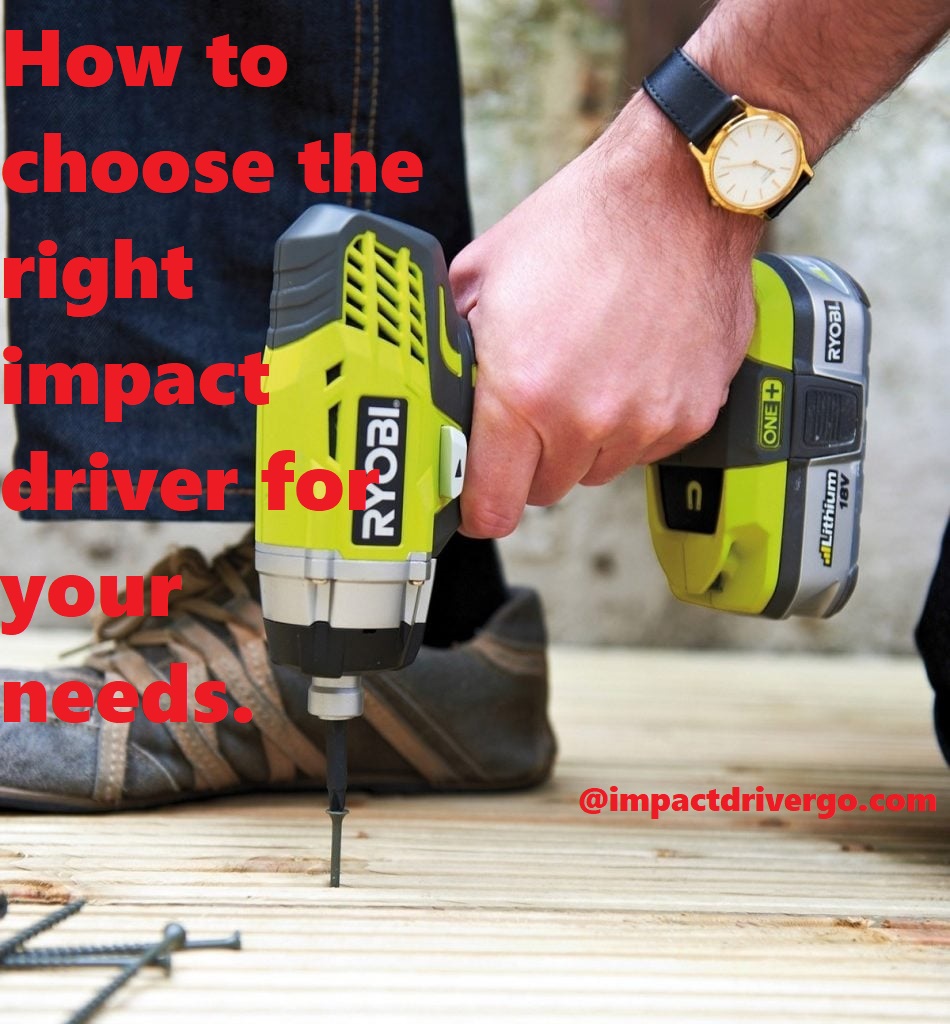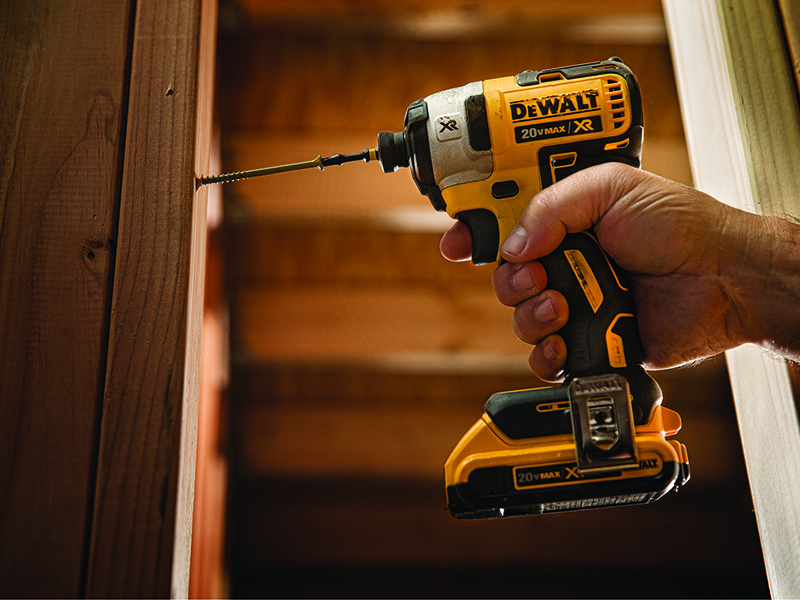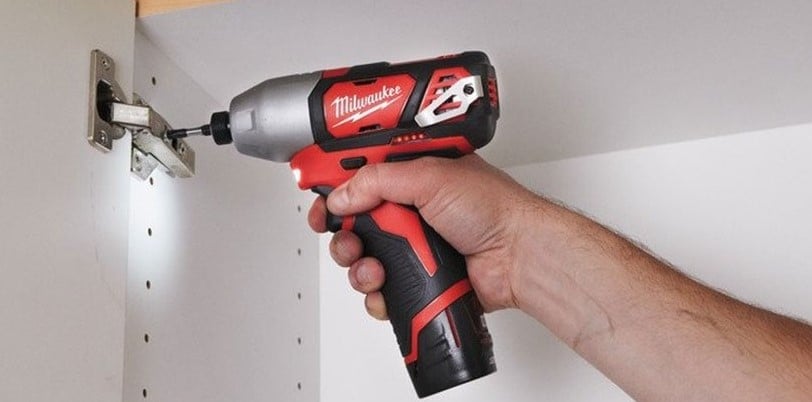Are you looking for the perfect impact driver to help you with fast and precise projects? Don’t worry, you are not alone. With so many models available on the market, choosing the right one that meets your needs can be a tricky job.
This guide will helps you to choose the right impact driver for your needs, so you can get your jobs done faster and more efficiently.
Impact drivers are becoming increasingly popular tools for DIYers and professionals alike. They combine the power and torque of a traditional cordless drill with the ability to quickly drive screws and bolts into a variety of materials.
In this guide, we’ll provide an overview of the different types of impact drivers available, explore how to choose the right one for your needs, and answer common questions about these tools. We’ll also cover various safety precautions that should be taken while operating an impact driver. So no matter what type of project you’re tackling, this guide will help you choose the best tool for the job.
Brief explanation of what an impact driver is
An impact driver is a tool used to drive screws and other fasteners into various materials. This power tool is designed to deliver more force than a typical screwdriver, so you’re less likely to strip screws or overdrive them. It achieves this better driving pressure by using hammering and rotational forces to plunge the fastener into the material.
The primary benefit of an impact driver is that it’s incredibly fast and efficient, which makes it very popular in assembly-line environments as well as in factories and on construction sites. Yet, it’s proved equally useful for home use — regardless of whether you’re a hobbyist or a professional — because it helps minimize fatigue due to its rapid firing action and also provides greater control over larger fasteners.
When shopping for an impact driver, there are several factors that need to be considered before making a purchase. It’s important to think about the tasks you’ll primarily be using your tool for, such as driving long screws into thick boards or shorter fasteners into hardwood. In addition, you should pay attention to your chosen weapon’s power source (battery size), operating speed (variable speed settings)and torque output so that you can choose one with enough muscle for the task with minimal risk of damage from overdriving or stripping the screw head.
Importance of choosing the right one
Choosing the right impact driver for your needs is important to make sure that you get the most out of your tool and don’t end up causing any damage to your project or yourself. Impact drivers are powerful tools that come in a variety of sizes, types, and abilities. The key to choosing the right one is to know what kind of tasks you will be doing, how often you plan on using it, and other important factors like torque settings and speed. Knowing this information will help you pick out the most suitable impact driver for whatever task you may have.
It’s important to note whether a corded or cordless impact driver is best for your task since this can be very influential in its overall performance. Cordless models offer more portability; whereas corded models usually have higher motor power outputs and faster speeds. Different jobs will require different torque settings as well; so be sure to check that too before purchasing an impact driver for any specific task.
Last but definitely not least – make sure that whatever model of impact driver that you choose fits into your budget can properly handle all of the tasks it will be used for safely!
Understanding Impact Drivers
Impact drivers are a type of power tool that use rotational force to deliver an impact. Impact drivers use a hammering action to deliver high torque for applications such as driving large fasteners, removing rusty bolts and even breaking down objects like concrete. They differ from regular power drills in the amount of torque they produce and their ability to handle more extreme uses. Understanding the basics of these tools can help you choose the right one for your needs.
Impact drivers are mainly categorized by size, speed, battery type and special features. Smaller impact drivers are typically used for small bolts or screws, while larger sizes can handle bigger fasteners as well as heavier materials such as metal or concrete. High speeds enable faster work, while lower speeds do not provide the same level of torque but require less energy consumption and are great for precise applications where accuracy is important.
The battery type determines how much power the driver will deliver – Lithium Ion batteries offer longer run times than NiCd batteries but tend to be more expensive. Special features vary between models but can include brushless motors, adjustable clutches and LED lights, which provide additional convenience when working with hard to reach surfaces in low light conditions.
Definition of impact drivers
Impact drivers are specialized tools that are used for driving screws, bolts and other fasteners into materials such as wood, metal or plastics. They use a combination of powerful motor torque, hammering force and a rotating head to achieve their results. The motor inside the tool is powerful enough to drive screws without damaging the material that they are being driven into. This makes them an ideal tool for completing jobs quickly, safely and efficiently.
Impact drivers differ from regular electric screwdrivers in terms of power output and design. They use a stronger motor for more torque and also utilize Impacts Smoothing Technology which helps to dampen vibration during rapid-fire driving applications; hence helping to reduce user fatigue. The rotating head produces an extra impact force which helps with anchoring or loosening stubborn screws or bolts; while variable speeds give the user more control over their application projects.
How they work
Impact drivers are versatile tools that use an internal mechanism to deliver high torque. The high-torque output can be beneficial for numerous projects, such as driving long deck screws, lag bolts and even fastening nuts and bolts.
Impact drivers use rotational movement (an electric motor or air compressor) which is then transferred to a hammering action via an internal moving parts assembly. This gives the tool superior hand-tightening force capabilities of up to 1,800 rpm for more demanding jobs.
Depending on the model, some impact drivers are equipped with a reverse switch so you can remove screws, nuts and bolts easily. They also have variable speed and torque controls so you can adjust them for the task at hand depending on its application. The drive type of most impact drivers is hexagonal in shape, which fits pleasingly into many different sizes of driver bits. This makes it compatible with both faster Phillips head or slotted bits as well as slower Torx head bits – making it great for any project that requires drilling holes into wood or metal surfaces.
Factors to Consider When Choosing an Impact Driver
When you’re shopping for an impact driver, there are a few key factors you should consider so that you’ll be sure to find the best tool for your needs.
Power: Impact drivers generate a lot of torque, so it’s important to make sure that the model you choose has enough power to get the job done. Determine how much torque or driving force your tasks require and select an impact driver with at least that amount of power.
Size: Impact drivers come in many sizes, from ultra-compact models designed for tight spaces to large, heavy-duty versions which are better suited for industrial applications. Consider where and how you plan to use the tool and select a model accordingly.
Bits: If possible, buy a driver with two sets of bits – one set with Phillips/flathead heads and one set configured as hex socket bits. This will give you more versatility when it comes time to work on specific projects.
Battery Type: The majority of impact drivers on the market today are powered by lithium-ion batteries; but there some models equipped with NiCad batteries available as well. Generally speaking, lithium-ion batteries have significantly more powerful performance than NiCad batteries, but they are also more expensive; deciding which type is best for your needs will depend on the amount of money you wish to spend vs. the power requirements of your projects.
Power source (corded or cordless)
The power source of the impact driver will have a direct effect on the performance. One of the most important considerations is whether you want a corded or cordless tool. A corded impact driver usually has more power than a similar wattage cordless model because it runs directly from wall power and does not lose energy to transferring electricity from its battery to the motor. While a corded impact driver will never run out of battery charge, the limited range of motion can be a serious disadvantage for larger projects that require you to move around across a job site.
At the same time, various advancements in battery technology have meant that modern lithium-ion batteries are able to last longer and deliver higher levels of power than ever before. Cordless models offer improved portability and mobility when dealing with projects in remote areas or hard-to-reach places as they do not rely on any external power sources. However, there is still no substitute for sheer wattage, so if you are looking for raw power then you should opt for a high voltage corded model over anything else.
Torque output
When deciding what impact driver to purchase, the amount of torque it outputs is perhaps the most important factor. The torque output of an impact driver is measured in inch pounds (in-lbs). The higher the number, the more power and torque the driver has and the better it will perform on harder materials. Low torque impact drivers are capable of driving screws into softwood, but for most construction or repair projects involving hardwood, metal or other dense materials preferences should be given to high torque impact drivers.
Impact drivers on average range from 1,500-2,500 in-lbs but certain industrial models can offer up to 4,000 in-lbs. It’s important to take into account how much power your project requires when choosing an impact driver.
Speed settings
Impact drivers come in a variety of speed settings that can help you determine the amount of force with which to drive screws. The higher the speed setting, the more power applied to the screw. Many quality impact drivers have variable speed settings, allowing you to choose the right level of force for each application.
Additionally, many impact drivers offer various torque settings ensuring the correct torque level is used in order to not cause damage to delicate materials. Matching up these two settings will give you better control and accuracy on all your projects.
When choosing an impact driver, look for one with variable speed and torque settings so that you can adjust them as circumstances require.
Maintenance and Safety Tips
In addition to choosing the right impact driver for your needs, there are several maintenance and safety tips you can use to ensure successful operation and long-lasting performance. Below are some essential maintenance and safety tips for a wide range of impact drivers.
Cordless Impact Drivers:
- Always wear safety glasses when operating your cordless impact driver.
- Frequently check the battery pack to make sure it is free from dirt and debris. Clean any existing dust away from the terminals with a soft cloth.
- Check the battery pack’s connection on a periodic basis to ensure that it is secure and tight.
- Clean terminal connections with light oil once per month or whenever corrosion is detected on the terminals or wiring.
Air Impact Drivers:
- Always wear appropriate hearing protection when operating your air impact driver, as prolonged exposure to loud noise can cause permanent hearing damage over time.
- Always check air pressure level before running job, as too much pressure can damage internal components such as pistons, bushings, seals etc.
- Whenever possible, be sure to select an air hose of the proper size for your application; this will help protect components from damage due to excessive pressure during operation of the tool.
Proper maintenance of impact drivers
To maintain your impact driver tool in optimal condition, it’s important to lubricate its components periodically with a quality oil or silicone grease. Additionally, given an impact driver generates a lot of vibration during use, it’s important to check the components for wear and tear in order to detect any potential problems before operating the tool. Before and after each use, do a quick thorough inspection of your impact driver for loose connections, chipped casings or worn parts that may be caused by heavy use. Broken parts can cause significant damage resulting in issues that reduce the efficiency of your tool and even put you at risk of electrocution if left unchecked.
Furthermore, when storing your tool, make sure to disconnect it from the power source and store it in a clean dry place free from dust and debris. Impacts are sensitive tools so proper maintenance is key to making sure they last as long as possible with good performance.
Safety precautions when using impact drivers
Safety should always be a priority when using tools and power equipment. When using an impact driver, there are a few safety tips that you should keep in mind to ensure that you and your surroundings stay safe during use.
First, make sure you have the right workstation set up for your project. It is important to have adequate space for electrics, such as power cords, power strips, and any additional cables or wires. Make sure to check local codes and regulations related to the plug being used for the impact driver, if applicable. Additionally, have all of your materials ready before turning on the tool. Have all of your safety equipment ready as well so you can quickly don them if needed while working with the impact driver.
Before turning on the tool, familiarize yourself with how it operates so that you are aware of any hazards associated with operating the tool safely. For example, know how to turn off and unplug the tool in case of an emergency or accident so that you can quickly address any safety issues related to usage missed while operating it or immediately after shutting it off. Additionally, make sure that any attachments are properly connected before starting it up and wear necessary protective equipment such as goggles or a face shield at all times when working around impacts drivers due to potential flying debris caused by high-speed spinning blades or particles coming into contact with parts of your skin during operation of larger bits or heads attached to faster drills and impacts drivers running powerful motors.
Never modify coupling fixtures on accessories like chucks designed for use in impact drivers as this can lead too loosening over time during typical operation which can cause them to fly off suddenly releasing high speed rotating objects from inside which can cause personal injury especially at higher speeds. Always check screws attaching these components after every use ensuring firm connections for next use had before applying electrical current back again.
Stay safe when using impacts drivers by following these guidelines!
Conclusion
In conclusion, deciding on the right impact driver for your needs requires an understanding of its features and capabilities. Take your time to learn about its power mechanisms, output power, torque and size to ensure that you get an impact driver that can provide you with the performance levels you require. The durability of impact drivers is just as important as all other features, so make sure to research the product and read customer reviews before investing in one.
Additionally, keep in mind the accessories needed for your application and make sure that they are compatible with the model of your preferred impact driver. By taking into account all these elements, you can be assured that you will find the right one for any job.
FAQs
How do I choose an impact driver?
Consider factors such as torque, speed, battery life, and ergonomics.
How do I choose impact driver size?
Choose the size based on the type of work you will be doing and the size of the fasteners you will be using.
What is an impact driver and do I need one?
An impact driver is a power tool used for driving screws and other fasteners. You may need one if you frequently work with fasteners.
How much power do I need in an impact driver?
The power you need depends on the type of work you will be doing. Look for a driver with at least 1,000 inch-pounds of torque.
Is 20V enough for an impact driver?
Yes, 20V is enough for most impact driver tasks.
How strong should my impact driver be?
Your impact driver should have enough torque to handle the tasks you will be doing.
Which type of impact driver is best?
The best type of impact driver depends on your needs. Consider factors such as size, power, and battery life.
Does the size of impact driver matter?
Yes, the size of the impact driver matters. Choose a size that is appropriate for the work you will be doing.
Is a high impact driver better than a drill?
An impact driver is better than a drill for driving screws and other fasteners. A drill is better for drilling holes.
What is a 1/4 inch impact driver used for?
A 1/4 inch impact driver is used for driving small to medium-sized screws and other fasteners.
See Also-
- Best bit set for impact driver
- Best brushless impact driver
- Best cordless impact driver
- Best dewalt impact driver
- Best impact driver and drill set


